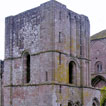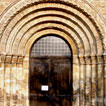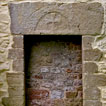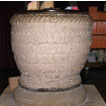The Normans and the New Church Order
Until the Norman conquest, Christianity in Wales had followed its own course – changes and reforms introduced by the Pope in Rome had largely passed it by. In contrast, the Normans were Catholics. As a result, when the Normans came to Wales they found a church that did not follow the expected rules, and they set about changing it to comply with their own ideas. This meant replacing the old clas system with monasteries under the rule of St Benedict for monks, and parishes to look after the spiritual welfare of lay people. The clergy in both sorts of institution were now expected to be celibate instead of marrying and passing on their office to their sons. All parishioners were expected to pay a tenth of what they produced (a tithe) to support their parish priest.
As Norman rule spread throughout South Wales, so did the parish system. In the lowland were the land was fertile, tithes of the agricultural produce they produced meant that parishes could be small. They were often linked with the manorial system, so that there was a single parish per manor. In contrast, parishes in the sparsely settled uplands were often huge – the parish of Ystradyfodwg, for example, covered most of the Rhondda. Most of these parish churches came under the jurisdiction of the Bishop of Llandaff, though everything to the west of the River Tawe (apart from Bishopston) was in the Diocese of St Davids. Llandaff had been a clas church, and its bishops still considered themselves the heirs to property over a much wider area in South Wales and the Marches. In order to support this claim, Bishop Urban put together around 1125 the Book of Llandaff, an extensive collection of charters. In the event, little more than the properties in the core area between the Wye and the Tawe were confirmed as belonging to the Diocese of Llandaff, but the collection still provide us which much useful information about the early church.
The Normans embarked on an extensive programme to provide new churches for every parish. As far as we know, these were the first stone churches to be built in South Wales. Their architecture is distinguished by round-headed arches and, compared with later medieval architecture, relatively small windows.
A number of the new Norman lords also founded monasteries to pray for the souls of themselves and their families. In at least some cases, the lands they granted to their new monasteries already belonged to communities of claswyr, and there are hints in the records of disputes between them and the incomers. The story of Llanthony Priory (Monmouthshire) is unusual, as a bottom-up foundation. The prime mover was a knight who received a calling to the religious life at a ruined chapel on the skirts of the Black Mountains. He was joined by a hermit who became the first prior when the community was persuaded to adopt the Augustinian rule at the beginning of the 12th century.





